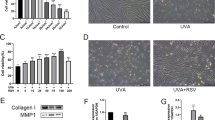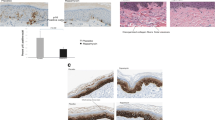Abstract
Apoptosis of human lymphocytes, induced by exposure to UV light (240–390 nm) at a dose of 1510 J/m2, is accompanied by a significant increase in the intracellular level of reactive oxygen species for 1–2 hours after irradiation. The addition of caffeine (10–4 mol/L) and genistein (10–6 mol/L) to UV-irradiated lymphocytes induces a decrease in the number of cells at the early stage of apoptosis by 11 and 23%, respectively, as compared to the control sample. The antiapoptotic effects of caffeine and genistein in relation to photomodified lymphocytes are related to their ability to reduce the level of reactive oxygen species in intact cells and UV-irradiated cells, as well as to inactivate hydrogen peroxide. Verapamil (10–4 mol/L), in contrast to the effects of caffeine and genistein, does not reduce the number of lymphocytes that are at the early stage of apoptosis, as compared to that parameter for photomodified free cells, but it demonstrates the effects of reducing the levels of reactive oxygen species in immunocytes.


Similar content being viewed by others
REFERENCES
Green, D.R. and Liambi, F., Cell death signaling, Cold Spring Harbor Perspect. Biol., 2015. https://doi.org/10.1101/cshperspect.a006080
Martynova, E.A., General ideas about the role of sphingolipids in signaling pathways of apoptosis, Patogenez, 2012, vol. 10, no. 2, pp. 16–28.
Artyukhov, V.G., Trubitsyna, M.S., Nakvasina, M.A., et al., Pathways of realization of apoptosis of human lymphocytes induced by UV light and reactive oxygen species, Radiats. Biol. Radioekol., 2011, vol. 51, no. 4, pp. 425–443.
Nakvasina, M.A., Lidokhova, O.V., Domanskaya, T.L., et al., Structural and functional modifications of human lymphocytes in the dynamics of development of UV-induced apoptosis, Radiats. Biol. Radioekol., 2015, vol. 55, no. 6, pp. 616–624.
Degasperi, G.R., Velho, J.A., Zecchin, K.G., et al., Role of mitochondria in the immune response to cancer: a central role for Ca2+, J. Bioenergetics, 2006, vol. 38, pp. 1–10.
De Petrillo, P.B., Abernethy, D.R., Wainer, I.W., and Andrawis, N.S., Verapamil decreases lymphocyte protein kinase c activity in humans, Clin. Pharmacol. Therap., 1994, vol. 55, no. 1, pp. 44–49.
Devasagayam, T.P., Caffeine as an antioxidant: inhibition of lipid peroxidation induced by reactive oxygen species, Biochim. Biophys. Acta, 1996, vol. 1282, no. 1, pp. 63–70.
Geraets, L., Caffeine metabolites are inhibitors of the nuclear enzyme poly(ADP-ribose)polymerase-1 at physiological concentrations, Biochem. Pharmacol., 2006, vol. 72, no. 7, pp. 902–910.
Bode, AnnM., The enigmatic effects of caffeine in cell cycle and cancer, Cancer Lett., 2007, vol. 247, no. 1, pp. 26–39.
Kim, I.G., Kim, J.S., Lee, J.H., and Cho, E.W., Genistein decreases cellular redox potential, partially suppresses cell growth in HL-60 leukemia cells and sensitizes cells to γ-radiation-induced cell death, Mol. Med. Rep., 2014, vol. 10, no. 6, pp. 2786–2792.
George, J., Genistein induces receptor and mitochondrial pathways and increases apoptosis during BCL-2 knockdown in human malignant neuroblastoma SK-N-DZ cells, J. Neurosci. Res., 2010, vol. 88, no. 4, pp. 877–886.
Limfotsity. Metody (Lymphocytes. Methods), Klaus, J., Ed., Moscow, 1990.
Wlodkowic, D., Flow cytometry-based apoptosis detection, Methods Mol. Biol., 2013, vol. 559, pp. 19–32.
Rastogi, R.P., Singh, S.P., Hader, D., and Sinha, R.P., Detection of reactive oxygen species (ROS) by the oxidant-sensing probe 2',7'-dichlorodihydrofluorescein diacetate in the cyanobacterium Anabaena variabilis PCC 7937, Biochem. Biophys. Res. Commun., 2012, vol. 397, no. 3, pp. 603–607.
Goldstein, S. and Czapski, G., Mannitol as an OH• scavenger in aqueous solutions and in biological systems, Int. J. Radiat. Biol., 1984, vol. 46, pp. 725–729.
Kalaeva, E.A., Artyukhov, V.G., and Kalaev, V.N., Teoreticheskie osnovy i prakticheskoe primenenie matematicheskoi statistiki v biologicheskikh issledovaniyakh i obrazovanii (Theoretical Foundations and Practical Application of Mathematical Statistics in Biological Research and Education), Voronezh, 2016.
Popova, N.R., Gudkov, S.V., and Bruskov, V.I., Natural purine compounds as radioprotective agents, Radiats. Biol. Radioekol., 2014, vol. 54, no. 1, pp. 38–49.
Grebenjuk, A.N., Basharin, V.A., Tarumov, R.A., et al., Experimental assessment of the radioprotective efficacy of genistein in terms of survival rates and bone marrow hematopoiesis of mice exposed to X-ray irradiation, Radiats. Biol. Radioekol., 2013, vol. 53, no. 5, pp. 468–474.
Grebenjuk, A.N., Tarumov, R.A., Basharin, V.A., et al., Experimental evaluation of the effect of synthetic genistein on hematological parameters and cytokine status of irradiated rats, Radiats. Biol. Radioekol., 2015, vol. 55, no. 2, pp. 160–168.
Grebenjuk, A.N., Tarumov, R.A., Basharin, V.A., and Kovtun, V.Ju., Experimental evaluation of the radioprotective effectiveness of synthetic genistein by indices of the glutathione system and lipid peroxidation in erythrocytes of the peripheral blood of irradiated rats, Radiats. Biol. Radioekol., 2015, vol. 55, no. 5, pp. 501–506.
Author information
Authors and Affiliations
Corresponding author
Ethics declarations
The authors declare that they have no conflict of interest. This article does not contain any studies involving animals or human participants performed by any of the authors.
Rights and permissions
About this article
Cite this article
Nakvasina, M.A., Tokmakova, E.V., Koltakov, I.A. et al. Antiapoptotic Effects of Caffeine, Genistein, and Verapamil in Relation to UV-Irradiated Lymphocyte Cells. Biol Bull Russ Acad Sci 47, 1547–1551 (2020). https://doi.org/10.1134/S1062359020110114
Received:
Published:
Issue Date:
DOI: https://doi.org/10.1134/S1062359020110114




